Cities and Regions of Ancient Egypt
The cities of ancient Egypt were built close to the Nile River so citizens could take advantage of the goods delivered by boat. Cities and towns were divided into “Upper” and “Lower” regions. Those cities closest to the Mediterranean Sea and the Nile Delta were considered “Lower” (because of the direction of flow of the Nile River) and cities farther south were regarded as “Upper.”
Memphis
The capital city of the Old Kingdom, Memphis was built by the kings of the First Dynasty and was one of the key religious centers, the other being Heliopolis. Although many gods were worshiped in Memphis, the Triad of Memphis consisted of Ptah, his wife Sekhmet and Nefertem, their son. Located roughly 15 miles south of modern day Cairo, Memphis was part of Lower Egypt. After Alexandria rose to importance in Greek-Roman times, Memphis eventually faded to ruins.
Click here to discover more about Memphis
Giza

Also located in Lower Egypt, Giza was a necropolis city for Old Kingdom royalty. Giza is famous for the pyramids built there, as well as the Great Sphinx.
The Great Pyramid of Khufu is one of the last ancient Seven Wonders of the World, rising to almost 500 feet. The other well-known pyramids of Giza included the Pyramid of Khafre and Menkaure. These structures are located on the Giza plateau.
Discover more about the pyramids of Giza
Rosetta
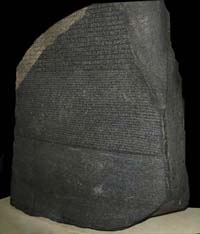
City where the famous Rosetta Stone was discovered in 1799 by Jean-Francois Champollion. The Rosetta Stone is known for being the key to deciphering the, up until that time, mysterious and undecipherable hieroglyphics. Located in Lower Egypt, Rosetta was founded in 800 AD and was an important trading city because of its key location on the Nile and Mediterranean. At one time it was a cosmopolitan coastal city with a monopoly on delta-grown rice, however, it eventually declined with the growth of Alexandria.
Aswan
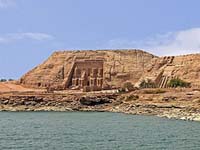
Located in Upper Egypt, Aswan marks the location of the first cataract as the Nile River flowed north to the Mediterranean. Aswan is the location of the Temple of Isis and the Rock Temples of Queen Nefertari and Ramses II. The construction of the Aswan High Dam threatened the Temples of Philae and Abu Simbel and so these rock temples were relocated several hundred feet inland for their preservation.
Thebes
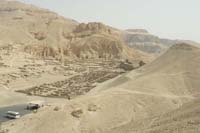
One of the most notable cities of ancient Egypt, Thebes was the capital city of the Middle and New Kingdom ruling dynasties. The Triad of Thebes consisted of Amun, Mut and her son, Khonsu. Located in Upper Egypt, Thebes is also the location of two major temples, Karnak and Luxor. Opposite the city on the western bank of the Nile River sits the desert necropolis known as the Valley of the Kings and Queens.
Click here to discover more about Thebes
The Theban Necropolis
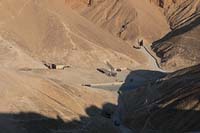
Opposite the city of Thebes, on the Western bank of the Nile River, sits the famous desert necropolis that houses a large number of monuments, tombs and temples. With more than 100 discovered tombs, the area was split into two parts - The Valley of the Kings and The Valley of the Queens. This has been a center of archaeological interest since the late 18th century. The most famous discovery is probably KV62, the tomb of Tutankhamun.
Click here to discover more about The Valley of the Kings
Heliopolis
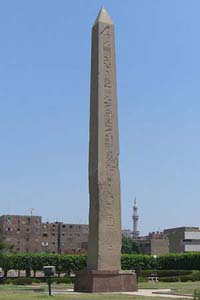
In pre-dynastic times, Heliopolis was the largest city and most important religious center in ancient Egypt. Literally meaning “City of the Sun”, ancient Egyptians believed it to be the birthplace of Atum, the sun god, as well as the Ennead of Heliopolis which consisted of Isis, Geb, Atum (Ra), Nut, Osiris, Set, Tefnut, Shu and Nephthys. Located in extreme Lower Egypt, the Temple of Re-Atum obelisk is the only remaining monument from ancient times.
Abydos
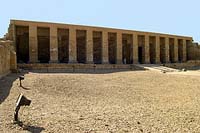
Located in Upper Egypt, Abydos was the mythical burial place of Osiris and was also his cult center. Some of the famous monuments and temples include the Temple of Seti I and the mortuary complex of Queen Tetisheri, known as “The Mother of the New Kingdom.” It was the favorite burial place for kings of the old kingdom. A List of Kings located in the Temple of Seti I helped historians put all of the Egyptian kings in their proper order of succession from Menes to Seti.
Click here to discover more about The Temples of Abydos
Thinis
Located in Upper Egypt, Thinis was the capital city before it was relocated to Memphis. The first Pharaohs are buried here and after the third dynasty, Thinis faded in importance. The cult center of the war god, Anhur, Thinis as an archaeological site has never been found, though it is well-documented by ancient writers.
Crocodilopolis
The modern day city now called Faiyum, the “Crocodile City” was the cult center of Sobek, the crocodile god. Sobek was one of the most important gods of ancient Egypt, as for many he represented power, fertility, and the might of the army. He also starred in many creation myths. Located in Lower Egypt, it is one of the oldest cities as well as one of the oldest continuously inhabited cities in the world since it was founded in 4,000 BC.
Avaris
Located in Lower Egypt, Avaris was the capital of Egypt when it was under Hyksos rule during the 15th Dynasty. The Hyksos were foreigners who first settled in the region and then seized control. Now modern day Tel El-Daba, Archaeologists have uncovered a mud brick vaulted tomb that belonged to a warrior who was interred with his weapons including a beautifully preserved copper sword, the first of its kind to be found in Egypt.
Dendera
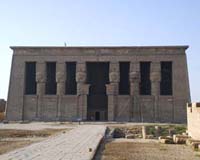
Located in Upper Egypt, Dendera is home to the Dendera Temple Complex, which contains the Temple of Hathor. It is considered to be one of the best preserved temples in all of Upper Egypt. As the cult city of Hathor, The Temple of Hathor was used for many functions in ancient times including a place of pilgrimage where citizens could be miraculously cured, a hospital that practiced magical therapies as well as the central location for many festivals.
Edfu
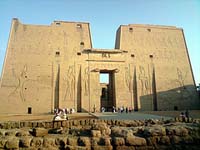
The site of another well-preserved temple, the Temple of Edfu, also known as The Temple of Horus, was constructed on top of earlier temples. Located in Upper Egypt, the Temple of Horus was an incredible source of information regarding ancient Egyptian political and religious thought. An enormous statue of Horus as a falcon is one of the most notable and famous statues that still stand today.
Elephantine
An island situated in the Nile River between Egypt and Nubia, Elephantine today is part of Aswan. It was the cult center for Khnum, Satet and their daughter Anuket. Hapi, god of the annual flooding of the Nile River, was worshiped here. It was the outer post of the Egyptian Empire as it sits just north of the First Cataract of the Nile River.
Hermopolis
An important religious center that favored Thothas the creator god. This cult center in Upper Egypt was called Khmun by the ancient Egyptians. Hermopolis is known for the Hermopolitan Ogdoad of eight gods who created the world which consisted of four pairs of males and females. These pairs included Amun and Amaunet, Huh and Hehet, Kek and Keket, Nun and Naunet.
Kom Ombo

Located north of Aswan in Upper Egypt, Kom Ombo is home to the Kom Ombo Temple. This unique temple is famous because it is a double temple with mirrored images with one side dedicated to Sobek and the other to Horus. Each side has its own entryway and chapels. Kom Ombo was originally called Nubt, meaning the City of Gold.
Click here to discover more about Kom Ombo
Alexandria
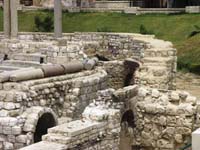
Founded by Alexander the Great in 331 B.C., Alexandria was the intellectual center of the ancient world. Its location along the Mediterranean made it one of the busiest and most prosperous of ancient Egyptian cities, as it is today. However, due to nearly continuous war, much of the ancient city has been lost. It is believed that Cleopatra and Mark Antony’s tomb is located somewhere near Alexandria, though it has never been found.
Click here to discover more about Alexandria
Saqqara
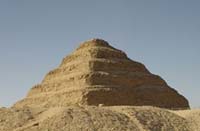
Located in Lower Egypt, Saqqara was used as an ancient burial ground. Among the most famous structures is the Step Pyramid of Djoser, also known as the Step Tomb. Nearly 20 ancient Egyptian kings built their pyramids here, which served as a necropolis for kings living and dying in Memphis.
Click here to discover more about Saqqara
Hierakonpolis
Defined as the “City of the Hawk,” the city worshiped Horus. Located in Upper Egypt, Hierakonpolis is one of the oldest and, at the time, most prosperous of ancient Egyptian cities. The Palette of Narmer, one of the first political documents in history, was found here. This palette is actually a slate carving that commemorates King Narmer’s victory of southern Egypt over northern Egypt and the unification of the two.
Leontopolis
Defined as the “City of Lions,” the city worshiped lion gods and deities that incorporated lions and cats. Leontopolis was the cult center for lion gods associated with Ra. Originally named Taremu by the ancient Egyptians; Leontopolis was located in Lower Egypt. An enclosure found here is thought to be one built by the Hyksos, it is known as the “Hyksos Camp.”
Hermonthis
Today known as the city of Armant, Hermonthis was once the cult center of Menthu. Menthu as associated with strength, war and bulls. Located in Upper Egypt, Hermonthis became a bustling, important city during the 18th Dynasty.
Sais
Known as Zau in ancient Egyptian times, Sais is located in Lower Egypt in the western region of the Nile Delta. During the 24th Dynasty, Tefnakhte I and Bakenranef made Sais their capital for the 12 years of their combined reigns.
Xois
Also named "Khasout" or "Khasouou", the city of Xois served as the capital of Egypt before this was moved to Thebes. It was a prosperous metropolis from where 76 Egyptian kings originated, and it was famous for the wines and luxurious goods it provided.
